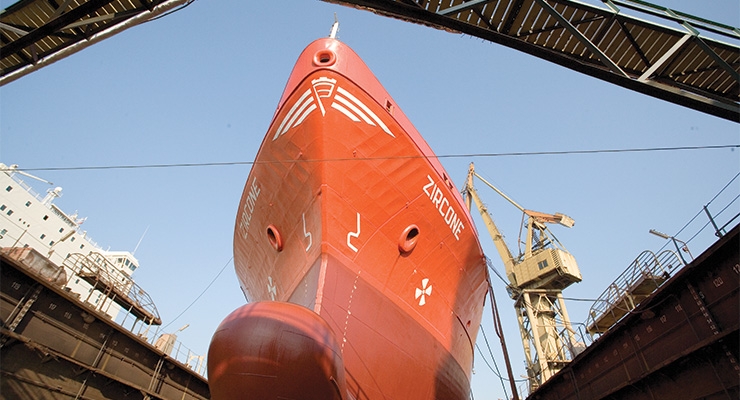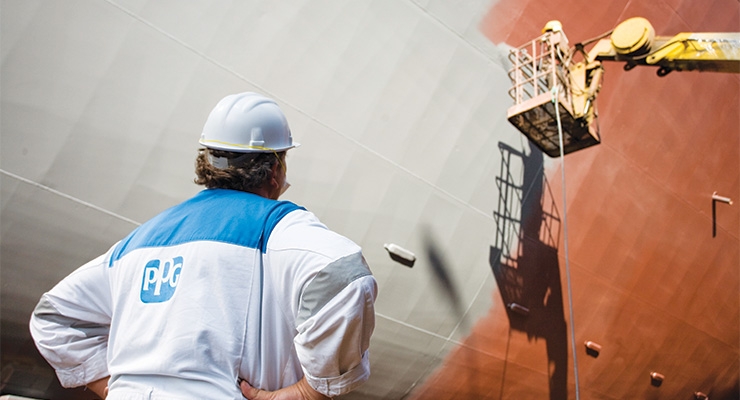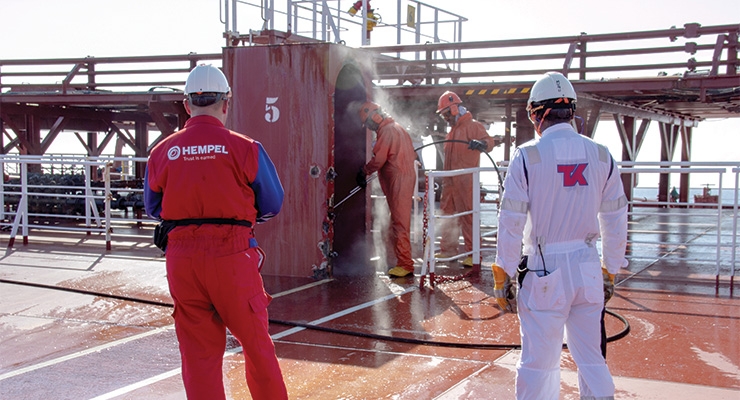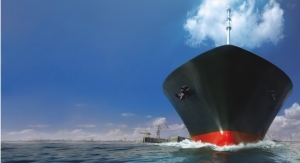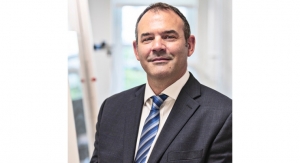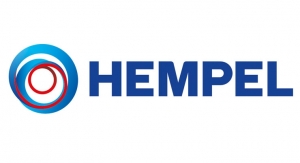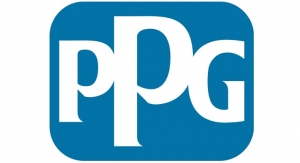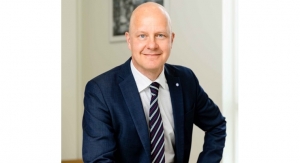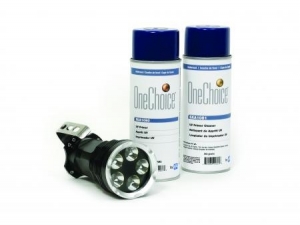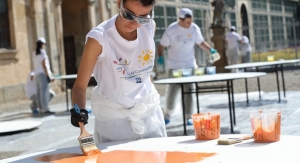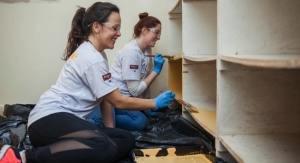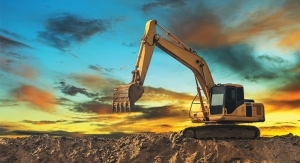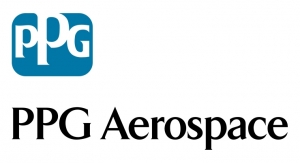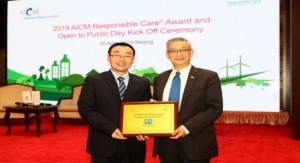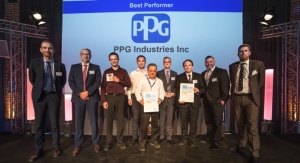Anthony Locicero, Associate Editor08.09.19
The marine coatings market size is forecasted to surpass $15 billion by 2024 at approximately seven percent CAGR from 2016 to 2024, according to research by Global Market Insights.
A growing need for low fuel consumption will enhance the demand for regular coating by anti-fouling agents, GMI said.
“Predictably, the coatings market remained very competitive in 2018,” said Christian Ottosen, group VP, head of Marine, Hempel A/S. “The price for raw materials increased more than anticipated, which affected the entire coatings industry. There were sustained tough market conditions in the marine industry globally. The marine newbuild markets in Asia and Europe continued to decline but there was a rise within marine maintenance.
“We see 2019 as a year of progress and overall the global coatings market is expected to pick up.”
“The commercial marine coatings industry in North America has seen steady growth since the beginning of 2018, and we see it continuing at a similar pace through 2019 and into next year,” added Al Kaminsky, U.S./Canada marine director for PPG Protective and Marine Coatings.
The Maritime Organization’s Sulphur cap is slated to go into effect on Jan. 1, 2020. It will rise from 0.5 percent to 3.5 percent.
“Many shipowners have put their vessels in drydock to retrofit their vessels, install a scrubber, and simultaneously apply marine coatings,” Ottosen said. “As the industry continues to search for the most efficient way of operating, suppliers strive to deliver solutions that impact the bottom line for their customers, either by a low upfront investment or reducing their fuel consumption.”
“Any uptick in the oil and gas industry leads to an uptick in the North American commercial marine coatings market,” Kaminsky added. “Barges and tugs up and down the Mississippi River and throughout the Great Lakes region, either directly related to the oil and gas industry or to the general economy, enhance the growth in the marine coatings market.”
Areas of growth
According to GMI, Asia Pacific, led by China, South Korea and Japan, has made “tremendous” advancements in the shipbuilding industry.
China emerged as the global leader, the research states, with new orders accounting for more than 33 percent of the global shipbuilding industry.
Asia Pacific will have a significant share of the overall industry owing to large-scale shipbuilding activities in China, Japan, South Korea, Philippines and Taiwan, per GMI’s research.
“The areas with the greatest demand for marine coatings directly correlates with the countries with the highest tonnage,” Ottosen said. “In Europe, for example, major shipping countries such as Greece, Germany, Norway (the maritime hubs) continue to have the highest demand for marine coatings. Asia (specifically Japan, China, Singapore) also has a high demand.”
Regulations
The Biocidal Products Regulation (BPR, Regulation (EU) 528/2012), as definted by the European Chemicals Agency, concerns the placing on the market and use of biocidal products, which are used to protect humans, animals, materials or articles against harmful organisms like pests or bacteria, by the action of the active substances contained in the biocidal product.
“Now all biocidal products require an authorization by European Chemicals Agency before they can be placed on the EU market,” Ottosen said. “What’s more, the active substances contained in that biocidal product must also be previously approved. All coatings suppliers, Hempel included, have developed products that are compliant with these new regulations and use approved biocidal and active substances.”
Hempel is prepared if China and Korea adopt similar legislature, Ottosen noted.
“There has been a global shift these past 10 years and protecting the environment is at the top of the agenda,” he said. “With increasing, and evolving, environmental regulations we strive to be as up to date as possible to help our customers be aware of and comply with new regulations and to help them minimize their environmental footprint.”
Kaminsky said PPG has observed an increase in some states requiring the use of anti-fouling coatings.
While it’s not mandatory, “we’re addressing those as they come up,” he added.
Raw materials
In addition to increasing regulations, the industry has faced challenges with raw materials prices and supply issues.
“Supply issues are always a problem, but the rise of raw material prices over the past couple of years has been a challenge to address,” Kaminsky said. “And trying to keep prices steady – in light of this – is always a struggle.”
“Raw materials constitute a major part of the cost of manufacturing coatings for the protective, marine and decorative industries,” Ottosen added. “In February 2017, we gave notice that we were going to increase the prices of certain products and explained the reasons behind this decision.”
Additionally, Ottosen said Hempel is “very committed to providing sustainable solutions to our customers that minimize their impact on the environment and do not jeopardize the health and safety of their employees.”
Hempel’s Group Health, Safety and Environmental Policy sets out the company’s commitment to seek out safer materials when developing new products and solutions, Ottosen explained.
“We also work to phase out materials that are potentially harmful to the environment and people’s health,” he said.
“We prioritize raw materials based upon their potential hazard and are committed to reducing or phasing out the more hazardous substances – known as red raw materials,” Ottosen continued. “Our priority list centers on carcinogenic, mutagenic and reprotoxic (CMR) substances. In 2018, we also included substances that the EU has decided to phase out in the future.
“By the end of 2018, we had completely stopped the manufacture and sale of all coal tar products,” he added. “We had also made good progress on other red raw materials by changing our solvent blends and phasing out raw materials that contain alkyl phenol ethoxylates.”
Hempel phased out 35 red raw materials last year, Ottosen said.
Trends
The anti-corrosion coatings segment is expected to lead the marine coatings market through 2022, in terms of value, per ReportBuyer.
“Energy efficiency continues to be key to successful operations and has three main drivers – economics (improving profit margins), compliance (industry regulations) and customer needs (sustainability and environmental factors),” Ottosen said. “When looking specifically at marine coatings, ship owners and operators look for solutions that minimize speed loss thus reducing fuel consumption and improve operational efficiency. Slow steaming, though not a new concept, is being adopted more and more by ship owners across the world as it means vessels burn less fuel by moving at a slow speed. We have developed trusted solutions to suit such operating patterns.
“As market pressures continue to drive ship owners to implement energy efficient solutions that are both environmentally sustainable and boost their competitiveness, we will continue to push technological boundaries to meet these needs.”
“The current trend in the North American marine coatings market is single application tank lining products,” Kaminsky added. “Minimizing the length of time that an asset is out of the water for maintenance and repair is critical, so single application coating technologies are an important development – to save time and money.”
Product releases
This year, Hempel released Globic 7000 and Atlantic+ to the market.
Globic 7000 is a new antifouling coating with enhanced operational flexibility for all vessel types and a speed loss of 4.5 percent, on average (according to ISO 19030).
Specifically designed to deliver effective protection for up to 60 months, Globic 7000 incorporates an optimum biocide mix to guard against both hard and soft fouling. With an improved performance against slime and algae, Globic 7000 is suitable for wide operational conditions including slow steaming and long idle periods.
Atlantic+ is designed to protect the hull from fouling throughout service intervals of up to 60 months.
Ensuring complete operational flexibility, the new antifouling is suitable for all vessel types and all water temperatures.
Atlantic+ incorporates a powerful biocide package and proven binder system.
This ensures progressive and controlled self-polishing from the moment the hull hits the water and for up to 60 months thereafter.
PPG is offering NOVAGUARD 810 ER and PSX ONE.
NOVAGUARD 810 ER is a single coat solution for ballast tanks and various cargo vessel applications that provides durable, long-term protection of the asset.
PSX ONE is a single pack acrylic polysiloxane solution that provides outstanding color and gloss retention in a durable coating product.
Chugoku Marine Paints introduced a new antifouling coating containing the barnacle-repellent active agent Selektope, SEA PREMIER 3000 PLUS, which is the eighth product developed by CMP that contains Selektope.
SEA PREMIER 3000 PLUS is a self-polishing coating based on silyl polymer technology. It delivers excellent slime and algal resistance with the combined power of Selektope and cuprous oxide for superior hard fouling prevention. Developed initially for use in the Japanese domestic market by coastal vessels, SEA PREMIER 3000 PLUS is particularly suitable for vessels operating with a low activity rate or at low speed. The coating is also suitable for use in niche areas, such as sea chests and interior-grating-bow thruster tunnels.
Nippon Paint Marine released Ever Cool, a specially formulated coating designed to reduce the effect of the Sun’s infrared rays on ship operations.
For example, the temperature difference between a deck coated with conventional paint system and one with Ever Cool can be up to about 28°C (82.4°F), with the specially formulated coating reflecting up to 80 percent of the Sun’s heat from colored coatings.
Requiring no special application tools or processes, Nippon Paint Marine uses advanced formulated reflective pigments to prevent surface temperature increases and lower heat transfer through steel plate and other structures.
“By reducing the surface temperatures of exposed decks, shipbuilders can reduce the insulation requirement, while ship operators can reduce the air conditioning/chiller load, saving fuel and improving the onboard conditions for passengers and crew, especially in tropical climates,” said Olaf Töbke, director, Nippon Paint Marine (Europe).
In addition to decks, the heat resistant coating can also be applied to the topside of ballast water and cargo tanks, to ensure their contents remain at a safe and steady temperature. The technology is also applicable to LNG insulated tanks to lower boil-off gases.
Jotun unveiled the next generation of its SeaForce biocidal antifouling range, with three new products featuring Hydractive technology.
The new solution provides predictable, long-term performance for diverse vessel needs.
Jotun originally launched its SeaForce range in 2004. Since that point, there has been some 27,000 vessel applications worldwide.
However, according to Dr. Erik Risberg, global marketing director, Jotun Marine Coatings, evolving customer needs have spurred Jotun to develop an innovative new solution to satisfy industry demands today, and far into the future.
“SeaForce is a cornerstone portfolio in our marine coating range,” he said, “but we felt the time was right to push its performance further, providing next-level protection for our customers while consolidating its position within the marketplace. Shipping has changed over the past decade and a half, creating a different customer need, and we want to evolve with that demand to keep delivering optimal solutions. That, in essence, led to the idea for Hydractive technology.”
Hydractive technology effectively slows down the water uptake of the antifouling, meaning that biocides are released in a more predictable pattern over the lifetime of the coating. This results in stable, high-quality performance for the long-term, with SeaForce keeping customers’ vessel hulls cleaner, for longer.
The range features three core products: SeaForce Shield, offering effective protection; SeaForce Active, actively working to safeguard hulls even when vessels are not in use; and SeaForce Active Plus, delivering premium protection at an affordable price.
SeaForce Active and SeaForce Active Plus also feature a triple biocide package, one of which is the same biocide combination used in the top of the range SeaQuantum product portfolio.
“There is no ‘standard’ ship owner, so there is no one size fits all coating solution,” Risberg said. “With our proprietary Hydractive technology we can deliver a ‘best in class’ solution for long-term clean hulls and protection. We’re excited to see industry reaction to what we regard as a significant step forward in anti-fouling performance within this market segment.”
A growing need for low fuel consumption will enhance the demand for regular coating by anti-fouling agents, GMI said.
“Predictably, the coatings market remained very competitive in 2018,” said Christian Ottosen, group VP, head of Marine, Hempel A/S. “The price for raw materials increased more than anticipated, which affected the entire coatings industry. There were sustained tough market conditions in the marine industry globally. The marine newbuild markets in Asia and Europe continued to decline but there was a rise within marine maintenance.
“We see 2019 as a year of progress and overall the global coatings market is expected to pick up.”
“The commercial marine coatings industry in North America has seen steady growth since the beginning of 2018, and we see it continuing at a similar pace through 2019 and into next year,” added Al Kaminsky, U.S./Canada marine director for PPG Protective and Marine Coatings.
The Maritime Organization’s Sulphur cap is slated to go into effect on Jan. 1, 2020. It will rise from 0.5 percent to 3.5 percent.
“Many shipowners have put their vessels in drydock to retrofit their vessels, install a scrubber, and simultaneously apply marine coatings,” Ottosen said. “As the industry continues to search for the most efficient way of operating, suppliers strive to deliver solutions that impact the bottom line for their customers, either by a low upfront investment or reducing their fuel consumption.”
“Any uptick in the oil and gas industry leads to an uptick in the North American commercial marine coatings market,” Kaminsky added. “Barges and tugs up and down the Mississippi River and throughout the Great Lakes region, either directly related to the oil and gas industry or to the general economy, enhance the growth in the marine coatings market.”
Areas of growth
According to GMI, Asia Pacific, led by China, South Korea and Japan, has made “tremendous” advancements in the shipbuilding industry.
China emerged as the global leader, the research states, with new orders accounting for more than 33 percent of the global shipbuilding industry.
Asia Pacific will have a significant share of the overall industry owing to large-scale shipbuilding activities in China, Japan, South Korea, Philippines and Taiwan, per GMI’s research.
“The areas with the greatest demand for marine coatings directly correlates with the countries with the highest tonnage,” Ottosen said. “In Europe, for example, major shipping countries such as Greece, Germany, Norway (the maritime hubs) continue to have the highest demand for marine coatings. Asia (specifically Japan, China, Singapore) also has a high demand.”
Regulations
The Biocidal Products Regulation (BPR, Regulation (EU) 528/2012), as definted by the European Chemicals Agency, concerns the placing on the market and use of biocidal products, which are used to protect humans, animals, materials or articles against harmful organisms like pests or bacteria, by the action of the active substances contained in the biocidal product.
“Now all biocidal products require an authorization by European Chemicals Agency before they can be placed on the EU market,” Ottosen said. “What’s more, the active substances contained in that biocidal product must also be previously approved. All coatings suppliers, Hempel included, have developed products that are compliant with these new regulations and use approved biocidal and active substances.”
Hempel is prepared if China and Korea adopt similar legislature, Ottosen noted.
“There has been a global shift these past 10 years and protecting the environment is at the top of the agenda,” he said. “With increasing, and evolving, environmental regulations we strive to be as up to date as possible to help our customers be aware of and comply with new regulations and to help them minimize their environmental footprint.”
Kaminsky said PPG has observed an increase in some states requiring the use of anti-fouling coatings.
While it’s not mandatory, “we’re addressing those as they come up,” he added.
Raw materials
In addition to increasing regulations, the industry has faced challenges with raw materials prices and supply issues.
“Supply issues are always a problem, but the rise of raw material prices over the past couple of years has been a challenge to address,” Kaminsky said. “And trying to keep prices steady – in light of this – is always a struggle.”
“Raw materials constitute a major part of the cost of manufacturing coatings for the protective, marine and decorative industries,” Ottosen added. “In February 2017, we gave notice that we were going to increase the prices of certain products and explained the reasons behind this decision.”
Additionally, Ottosen said Hempel is “very committed to providing sustainable solutions to our customers that minimize their impact on the environment and do not jeopardize the health and safety of their employees.”
Hempel’s Group Health, Safety and Environmental Policy sets out the company’s commitment to seek out safer materials when developing new products and solutions, Ottosen explained.
“We also work to phase out materials that are potentially harmful to the environment and people’s health,” he said.
“We prioritize raw materials based upon their potential hazard and are committed to reducing or phasing out the more hazardous substances – known as red raw materials,” Ottosen continued. “Our priority list centers on carcinogenic, mutagenic and reprotoxic (CMR) substances. In 2018, we also included substances that the EU has decided to phase out in the future.
“By the end of 2018, we had completely stopped the manufacture and sale of all coal tar products,” he added. “We had also made good progress on other red raw materials by changing our solvent blends and phasing out raw materials that contain alkyl phenol ethoxylates.”
Hempel phased out 35 red raw materials last year, Ottosen said.
Trends
The anti-corrosion coatings segment is expected to lead the marine coatings market through 2022, in terms of value, per ReportBuyer.
“Energy efficiency continues to be key to successful operations and has three main drivers – economics (improving profit margins), compliance (industry regulations) and customer needs (sustainability and environmental factors),” Ottosen said. “When looking specifically at marine coatings, ship owners and operators look for solutions that minimize speed loss thus reducing fuel consumption and improve operational efficiency. Slow steaming, though not a new concept, is being adopted more and more by ship owners across the world as it means vessels burn less fuel by moving at a slow speed. We have developed trusted solutions to suit such operating patterns.
“As market pressures continue to drive ship owners to implement energy efficient solutions that are both environmentally sustainable and boost their competitiveness, we will continue to push technological boundaries to meet these needs.”
“The current trend in the North American marine coatings market is single application tank lining products,” Kaminsky added. “Minimizing the length of time that an asset is out of the water for maintenance and repair is critical, so single application coating technologies are an important development – to save time and money.”
Product releases
This year, Hempel released Globic 7000 and Atlantic+ to the market.
Globic 7000 is a new antifouling coating with enhanced operational flexibility for all vessel types and a speed loss of 4.5 percent, on average (according to ISO 19030).
Specifically designed to deliver effective protection for up to 60 months, Globic 7000 incorporates an optimum biocide mix to guard against both hard and soft fouling. With an improved performance against slime and algae, Globic 7000 is suitable for wide operational conditions including slow steaming and long idle periods.
Atlantic+ is designed to protect the hull from fouling throughout service intervals of up to 60 months.
Ensuring complete operational flexibility, the new antifouling is suitable for all vessel types and all water temperatures.
Atlantic+ incorporates a powerful biocide package and proven binder system.
This ensures progressive and controlled self-polishing from the moment the hull hits the water and for up to 60 months thereafter.
PPG is offering NOVAGUARD 810 ER and PSX ONE.
NOVAGUARD 810 ER is a single coat solution for ballast tanks and various cargo vessel applications that provides durable, long-term protection of the asset.
PSX ONE is a single pack acrylic polysiloxane solution that provides outstanding color and gloss retention in a durable coating product.
Chugoku Marine Paints introduced a new antifouling coating containing the barnacle-repellent active agent Selektope, SEA PREMIER 3000 PLUS, which is the eighth product developed by CMP that contains Selektope.
SEA PREMIER 3000 PLUS is a self-polishing coating based on silyl polymer technology. It delivers excellent slime and algal resistance with the combined power of Selektope and cuprous oxide for superior hard fouling prevention. Developed initially for use in the Japanese domestic market by coastal vessels, SEA PREMIER 3000 PLUS is particularly suitable for vessels operating with a low activity rate or at low speed. The coating is also suitable for use in niche areas, such as sea chests and interior-grating-bow thruster tunnels.
Nippon Paint Marine released Ever Cool, a specially formulated coating designed to reduce the effect of the Sun’s infrared rays on ship operations.
For example, the temperature difference between a deck coated with conventional paint system and one with Ever Cool can be up to about 28°C (82.4°F), with the specially formulated coating reflecting up to 80 percent of the Sun’s heat from colored coatings.
Requiring no special application tools or processes, Nippon Paint Marine uses advanced formulated reflective pigments to prevent surface temperature increases and lower heat transfer through steel plate and other structures.
“By reducing the surface temperatures of exposed decks, shipbuilders can reduce the insulation requirement, while ship operators can reduce the air conditioning/chiller load, saving fuel and improving the onboard conditions for passengers and crew, especially in tropical climates,” said Olaf Töbke, director, Nippon Paint Marine (Europe).
In addition to decks, the heat resistant coating can also be applied to the topside of ballast water and cargo tanks, to ensure their contents remain at a safe and steady temperature. The technology is also applicable to LNG insulated tanks to lower boil-off gases.
Jotun unveiled the next generation of its SeaForce biocidal antifouling range, with three new products featuring Hydractive technology.
The new solution provides predictable, long-term performance for diverse vessel needs.
Jotun originally launched its SeaForce range in 2004. Since that point, there has been some 27,000 vessel applications worldwide.
However, according to Dr. Erik Risberg, global marketing director, Jotun Marine Coatings, evolving customer needs have spurred Jotun to develop an innovative new solution to satisfy industry demands today, and far into the future.
“SeaForce is a cornerstone portfolio in our marine coating range,” he said, “but we felt the time was right to push its performance further, providing next-level protection for our customers while consolidating its position within the marketplace. Shipping has changed over the past decade and a half, creating a different customer need, and we want to evolve with that demand to keep delivering optimal solutions. That, in essence, led to the idea for Hydractive technology.”
Hydractive technology effectively slows down the water uptake of the antifouling, meaning that biocides are released in a more predictable pattern over the lifetime of the coating. This results in stable, high-quality performance for the long-term, with SeaForce keeping customers’ vessel hulls cleaner, for longer.
The range features three core products: SeaForce Shield, offering effective protection; SeaForce Active, actively working to safeguard hulls even when vessels are not in use; and SeaForce Active Plus, delivering premium protection at an affordable price.
SeaForce Active and SeaForce Active Plus also feature a triple biocide package, one of which is the same biocide combination used in the top of the range SeaQuantum product portfolio.
“There is no ‘standard’ ship owner, so there is no one size fits all coating solution,” Risberg said. “With our proprietary Hydractive technology we can deliver a ‘best in class’ solution for long-term clean hulls and protection. We’re excited to see industry reaction to what we regard as a significant step forward in anti-fouling performance within this market segment.”

